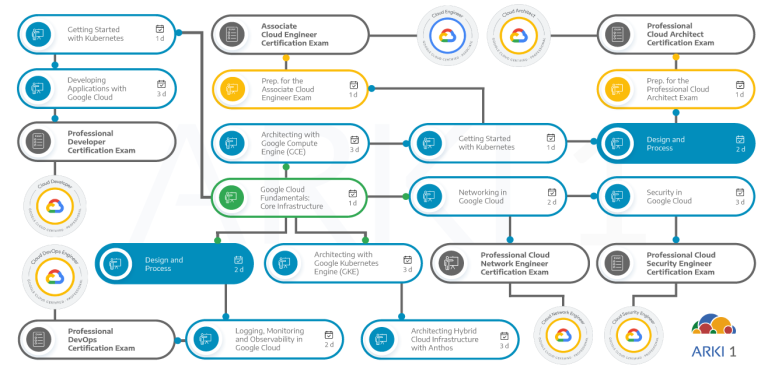Este curso apresenta uma combinação de palestras, atividades de design e laboratórios práticos para mostrar como usar padrões de design comprovados no Google Cloud para construir soluções altamente confiáveis e eficientes, além de operar implantações que são altamente disponíveis e rentáveis.
Este curso foi criado para aqueles que já completaram os cursos de Architecting with Google Compute Engine ou Architecting with Google Kubernetes Engine.
Objetivos
Neste curso, os participantes aprenderão as seguintes habilidades:
- Aplicar um conjunto de perguntas, técnicas e considerações de design
- Definir os requisitos da aplicação e expressá-los objetivamente como KPIs, SLOs e SLIs
- Decompor os requisitos da aplicação para encontrar os limites adequados dos microsserviços
- Aproveitar as ferramentas de desenvolvimento do Google Cloud para configurar pipelines de implantação automatizados e modernos
- Escolher os serviços de armazenamento do Google Cloud adequados com base nos requisitos da aplicação
- Discutir as arquiteturas de rede do Google Cloud, incluindo arquiteturas híbridas
- Implementar aplicações confiáveis, escaláveis e resilientes, equilibrando métricas chave de desempenho com custo
- Escolher os serviços de implantação do Google Cloud adequados para suas aplicações
- Proteger as aplicações, os dados e a infraestrutura na nuvem
- Monitorar os objetivos de nível de serviço e os custos usando o Cloud Monitoring
Público-Alvo
Esta aula é destinada ao seguinte público:
- Cloud Solutions Architects, Site Reliability Engineers, Systems Operations professionals, DevOps Engineers, IT managers.
- Pessoas que utilizam o Google Cloud para criar novas soluções ou para integrar sistemas existentes, ambientes de aplicação e infraestrutura com o Google Cloud.
Pré-requisitos
Para aproveitar ao máximo este curso, os participantes devem cumprir os seguintes critérios:
- Ter completado os cursos de Architecting with Google Compute Engine, Architecting with Google Kubernetes Engine ou ter experiência equivalente.
- Ter conhecimento básico em ferramentas de linha de comando e em ambientes de sistemas operacionais Linux.
- Ter experiência em operações de sistemas, incluindo a implantação e a gestão de aplicações, seja em ambientes locais ou em uma nuvem pública.
Duração
2 dias
Investimento
Consulte o valor atualizado e datas das próximas turmas abertas em nossa página de inscrições.
Caso tenha interesse em uma turma fechada para sua empresa, entre em contato conosco.
Resumo do curso
O curso inclui apresentações, demonstrações e laboratórios práticos.
- Describe users in terms of roles and personas
- Evaluate KPIs using SLOs and SLIs
- Determine the quality of application requirements using SMART criteria
- Decompose monolithic applications into microservices
- Recognize appropriate microservice boundaries
- Design consistent, standard RESTful service APIs
- Identify the 12-factor best practices for implementing services
- Discuss the automation of service deployment using CI/CD pipelines
- Explain how to leverage Cloud Source Repositories for source and version control
- Automate builds with Cloud Build and build triggers
- Manage container images with Container Registry
- Identify the use cases for Spanner
- Identify the use cases for Cloud SQL
- Identify the use cases for Firestore
- Identify the use cases for Memorystore
- Discuss the design of VPC networks to optimize for cost, security, and performance
- Describe how global and regional load balancers provide access to services
- Connect networks using peering and VPNs
- Define hybrid networks between Google Cloud and on-premises data centers using Cloud Interconnect
- Choose the appropriate Google Cloud deployment service for your applications
- Configure scalable, resilient infrastructure using Instance Templates and Groups
- Orchestrate microservice deployments using Kubernetes and GKE
- Leverage App Engine for a completely automated platform as a service (PaaS)
- Discuss the design of services to meet requirements for availability, durability, and scalability
- Identify the failures to be avoided to implement a fault-tolerant system
- Identify the best practices for designing secure systems
- Discuss the use of organizational policies and folders to simplify cloud governance
- Identify Google Cloud services that can be leveraged for access management
- Identify Google Cloud services that can be leveraged to mitigate DDoS attacks
- Discuss different ways to manage new service versions
- Describe how to forecast, monitor, and optimize service costs
- Observe if your services are meeting their SLOs using Cloud Monitoring and Dashboards
- Use Uptime Checks to determine service availability
- Respond to service outages using Cloud Monitoring Alerts


